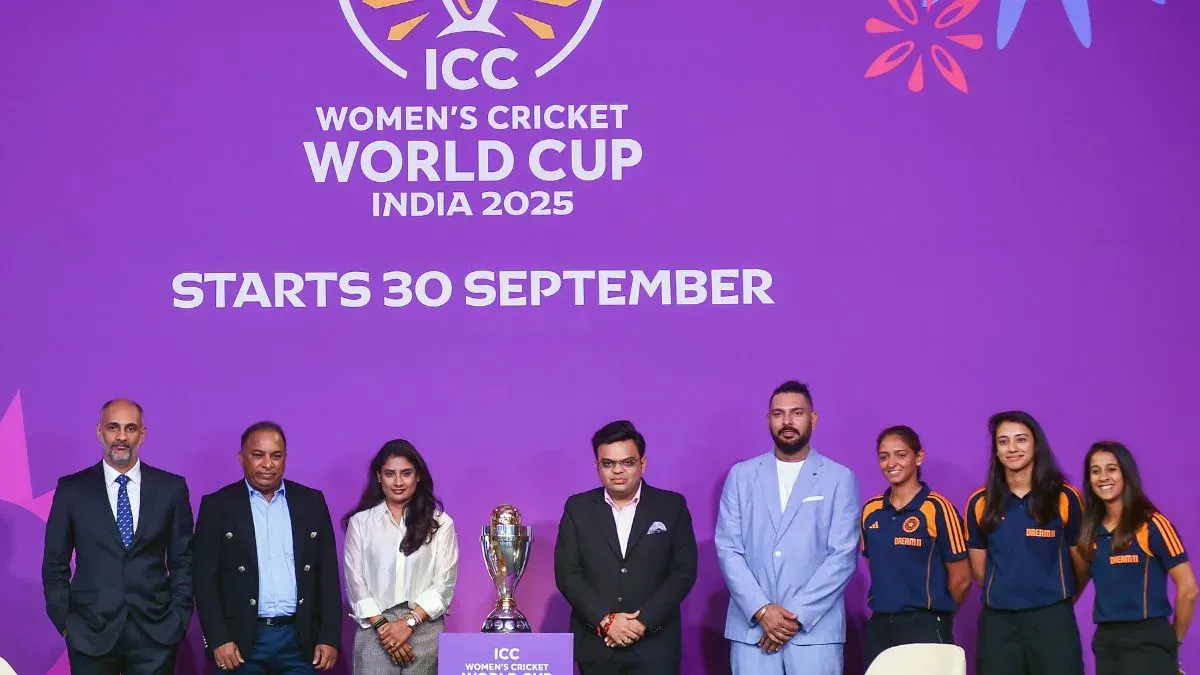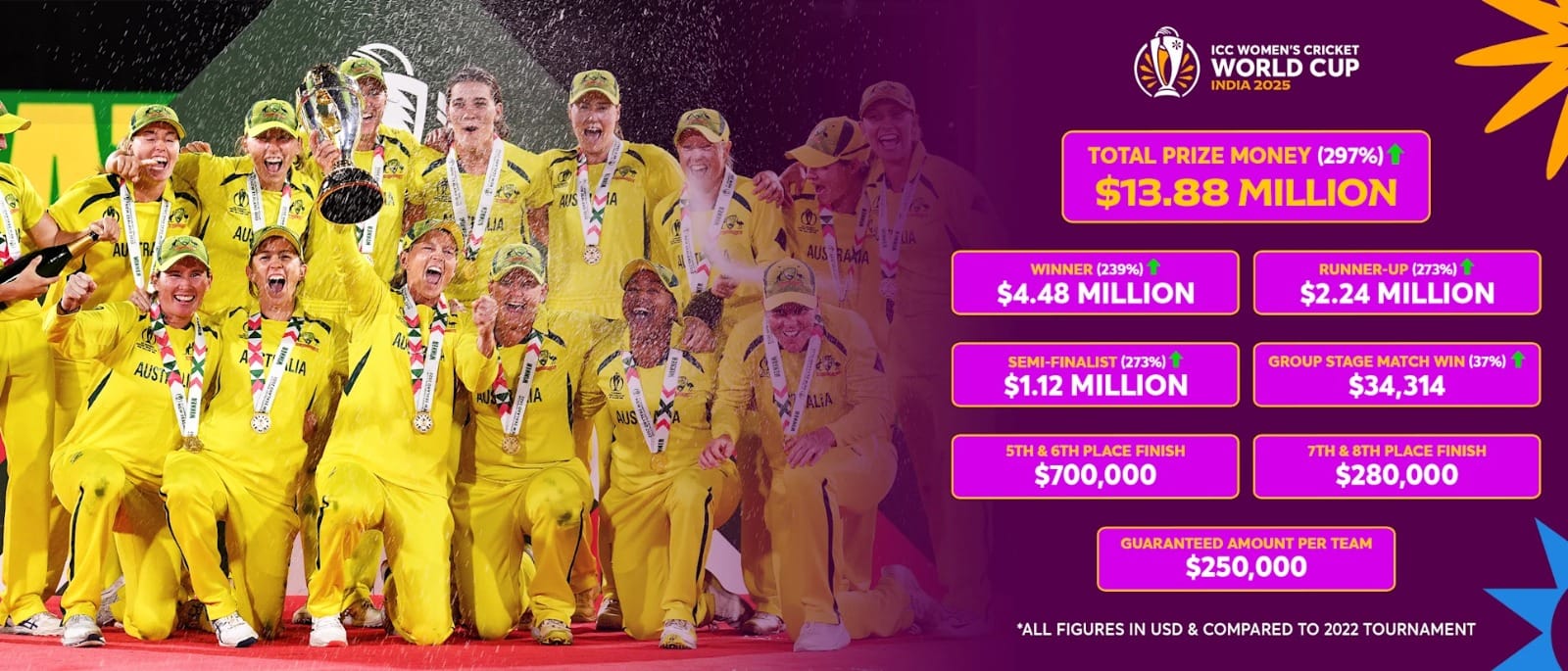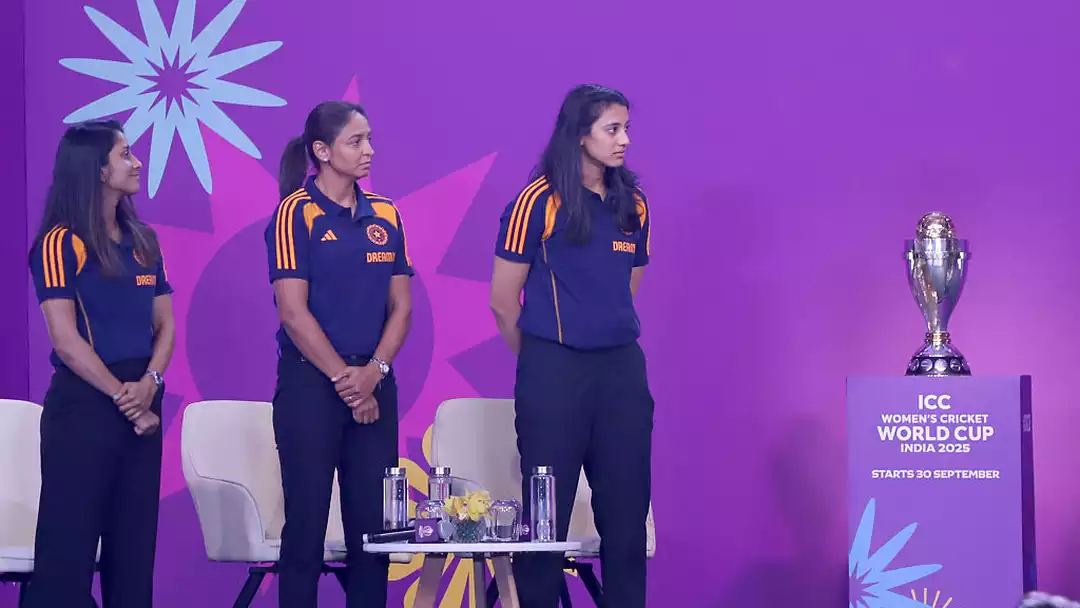A New Dawn: How the ICC Women’s ODI World Cup Prize Money Is Redefining Global Cricket
The ICC has announced a record $13.88 million prize pool for the 2025 Women's World Cup, surpassing the men's tournament. This landmark move marks a new era of pay parity in cricket.

Written by Lavanya, Intern, Allegedly The News
NEW DELHI, INDIA, September 2, 2025
The world of cricket is witnessing a historic shift. The International Cricket Council (ICC) has announced a record-breaking prize pool for the ICC Women's ODI World Cup 2025. Set to be jointly hosted by India and Sri Lanka, the tournament's total prize money has been quadrupled to a staggering $13.88 million (approximately ₹122.5 crore), a near 300% increase from the previous edition. This monumental leap is not just a financial upgrade; it's a powerful declaration of intent, signaling a new era of professionalism and equality in women's sports. What's even more significant? This prize pot eclipses the $10 million awarded at the ICC Men's Cricket World Cup in 2023. This is a game-changer, a bold stride towards financial parity that sets a new global benchmark.
The Record-Breaking Payout: A Detailed Breakdown
The ICC's new prize money structure is a meticulously crafted model designed to reward excellence at every stage of the tournament. The total prize pool of $13.88 million is the richest in the history of women's cricket, ensuring that every participating team receives a significant financial boost.
- Champions: The winning team will take home a massive $4.48 million (₹39.55 crore). This is a staggering 239% increase from the $1.32 million Australia won in the 2022 World Cup. This massive jump ensures the champions are rewarded commensurate with the pinnacle of achievement in the sport.
- Runners-up: The team that finishes second will not go unrewarded, earning $2.24 million (₹19.77 crore). This represents a remarkable 273% increase from the $600,000 England secured in 2022.
- Losing Semi-Finalists: The two teams that bow out in the semi-finals will each receive $1.12 million (₹9.89 crore), a significant increase from the $300,000 they would have earned in the last tournament.
- Group Stage Participants & Bonuses: Every team is guaranteed a participation fee of $250,000 (₹2.2 crore). In a new and impactful move, the ICC has also introduced a bonus for each group-stage win, with teams earning an additional $34,314 (₹30.29 lakh) per victory.
- Other Finishes: The teams finishing fifth and sixth will take home $700,000 each, while those in seventh and eighth place will earn $280,000 apiece.
This comprehensive distribution model is a testament to the ICC's commitment to building a financially sustainable ecosystem for the sport. It not only rewards the top-performing teams but also provides a vital financial lifeline to all nations, allowing them to invest in their domestic structures, player development, and infrastructure.
A Historical Perspective: From Volunteerism to Professionalism
The journey of women's cricket is a story of incredible resilience and unwavering passion. For much of its history, it was an amateur sport, with players often self-funding their careers and tours.
- Early Years & The First World Cup: The first Women's Cricket World Cup was held in 1973 in England, two years before the inaugural men's tournament. While a historic event, it was a far cry from the modern-day professional spectacle. Teams operated on shoestring budgets, and prize money was nonexistent.
- The Dawn of Professionalism: The early 2010s marked a crucial turning point. The introduction of central contracts by major boards like the ECB and Cricket Australia, along with the establishment of domestic T20 leagues like the Women's Big Bash League (WBBL), created the first pathways for players to earn a living solely from cricket. This was the initial catalyst that professionalized the game.
- The Game-Changing Pay Parity Announcement: On July 27, 2023, the ICC announced a landmark decision to achieve pay parity for all men's and women's events. This was not just a symbolic gesture; it was a firm commitment to a future where the financial rewards would be the same. This pledge was immediately put into action, with the ICC Women's T20 World Cup 2024 offering a total prize pool of $7.95 million, more than double the amount in 2023. This set the stage for the even more significant announcement for the 2025 ODI World Cup.
- The Indian Revolution - The WPL: The launch of the Women's Premier League (WPL) in India in 2023 was a watershed moment. The league's immense commercial success, with franchise rights sold for over ₹4,600 crore and media rights for ₹950 crore, proved beyond a doubt that women's cricket was a financially viable and highly marketable product. It brought in unprecedented investment and a new level of professionalism, inspiring a generation of young cricketers. The WPL's success served as a powerful economic argument for the ICC's pay parity policy.
The evolution from a volunteer-run sport to a global multi-million dollar industry has been a rapid and remarkable one. The 2025 World Cup prize money is the most powerful evidence of this journey, a validation of the blood, sweat, and tears of generations of female cricketers.

The Broader Impact: Transforming the Cricket Economy
The increased prize money is a catalyst for a larger economic transformation. It's a key ingredient in a virtuous cycle that is rapidly accelerating the growth of women's cricket.
- Elevating Performance Standards: When the financial rewards are substantial, so is the motivation. The promise of millions will push teams to new heights of performance. Players will have the financial security to focus entirely on their training, nutrition, and professional development, leading to a higher standard of play. This, in turn, makes the game more compelling for fans and broadcasters.
- Attracting New Talent: The financial viability of women's cricket as a career path will encourage more young girls to pursue it professionally. The knowledge that they can earn a lucrative living will inspire a new generation of athletes to dedicate their lives to the game, creating a deeper talent pool and a more competitive future for the sport.
- Broadcasting & Endorsements: This record payout sends a powerful message to brands and broadcasters: women's cricket is a safe and profitable investment. As viewership numbers continue to climb, so will media rights deals and sponsorship opportunities. This will lead to more high-profile endorsements for players, further transforming their economic fortunes and elevating their status as global sporting icons. The recent partnership between the ICC and Google to "transform the fan experience in women's cricket" underscores this trend of major global brands backing the women's game.
The rising tide of prize money, combined with lucrative broadcasting deals and endorsements, is creating a self-sustaining ecosystem for women's cricket. It is no longer just a passion; it is a burgeoning business poised for unprecedented growth.
The Indian Team's Opportunity and the Path Ahead
For the Indian women's team, the 2025 World Cup is more than a tournament; it's a golden opportunity. As co-hosts, they will have the dual advantage of playing on home soil in front of their passionate fans. The team, with its blend of experienced players and young talent, is a strong contender. They have been on the cusp of an ICC title multiple times, reaching the finals of the 2017 ODI World Cup and the 2020 and 2023 T20 World Cups.
Winning the World Cup at home would be a historic first and would bring immense financial rewards, catapulting the players to superstardom. The prize money, along with the expected increase in personal endorsements, would cement their financial security and status as national heroes. However, the pressure of a billion-plus expectations will be immense, and their ability to handle it will be a key factor in their success.
Global Fan Reactions: A Resounding Cheer for Equality
The announcement has been met with widespread and overwhelmingly positive reactions from fans, players, and commentators across the globe.
- Public Acclaim: Social media platforms have been flooded with messages of support, celebrating the move as "long overdue" and a "monumental step towards equality." The general sentiment is that this decision is a powerful statement about the value of women's sports and an inspiration for future generations.
- Expert Opinions: Experts have lauded the move as a defining moment. ICC Chairman Jay Shah called it a "defining milestone in the journey of women's cricket" and emphasized that the message is simple: "women cricketers must know they will be treated on par with men if they choose this sport professionally."
- A Broader Movement: The buzz has extended beyond cricket, with many calling for similar actions to be taken in other sports like football and basketball. This shows that the conversation around pay equity in sports is gaining momentum globally, with cricket leading the charge.
This universal acclaim highlights a crucial cultural shift. The public is not just accepting but actively celebrating gender equality in sports.

A Legacy of Empowerment
The ICC Women's ODI World Cup 2025 is poised to be more than a sporting event; it will be a historic moment in the fight for gender equality in sports. The record-breaking prize money is the culmination of years of struggle and a growing recognition of the immense talent and value of female athletes. This decision is a legacy of financial empowerment, sending a clear and powerful message to every aspiring cricketer around the world: your dedication is valued, your talent is recognized, and a professional career in this sport is not only possible but financially rewarding. The ICC has proven that a commitment to equity can transform a game and, in the process, change the world.
A Moment to Ponder
The ICC’s landmark decision is a testament to the growth of women's cricket, but it also raises important questions about the future:
- Beyond the World Cup: With prize money parity established for global events, what are the next steps? How can we ensure that domestic leagues and bilateral series also offer competitive and equitable pay for women cricketers?
- Sustaining the Momentum: Can the commercial success of leagues like the WPL and the public's positive reception to this prize money be sustained? How do we ensure that this isn't just a peak but a new, permanent baseline for the sport?
Sources
The Hindu, Business Standard, The Economic Times, ICC official media releases, Cricexec, and Storyboard18.




